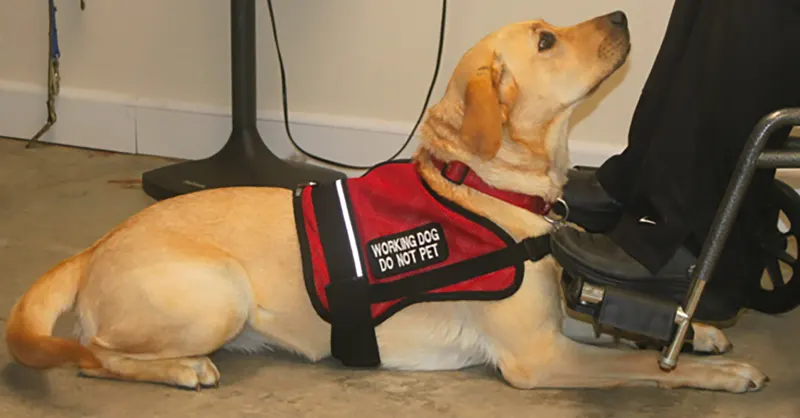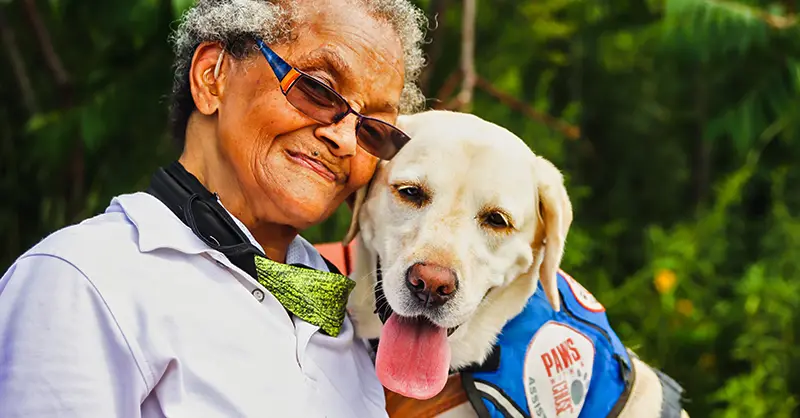Archive for the ‘Service Dog Tips’ Category
Your service dog can go with you almost anywhere, and this includes the open seas! Bringing your service dog on a cruise ship allows you to enjoy your vacation safely and comfortably, without extra worry about your health. Want to bring your service dog on a cruise ship? Keep reading to find out how you can have a cruise ship vacation with your service dog.
Service Dogs on Your VacationA service dog is there to give you more options for living your life safely with your disability — including on vacation. You deserve to have the vacation you want. And you can have the vacation you’re dreaming of because you have a service dog.
Traveling on vacation with your service dog takes some planning ahead. You’ll have to consider the needs of your service dog, opportunities for play, and keep in mind the environment you need for your service dog to be comfortable. Also, remember that, like on an airplane, physical space (especially within the cabins) is exceptionally limited. Practical issues like whether the size of an animal can be physically accommodated must factor into your vacation plans.
Show everyone that the rights of your service dog should be respected. Get your service dog registered below. Going On a Cruise With Your Service DogMost cruise ships are not pet-friendly. However, exceptions are made for service dogs, because a service dog is not a pet. Service dogs assist people who have a disability; therefore, most cruise ships make exceptions for service dogs.
Cruise ships are a convenient way to travel with your service dog, as long as you plan. Because cruise ships have smaller rooms than hotels, you may need to factor the size of your service dog into your travel plan. It’s best to contact the cruise line before purchasing a ticket to inquire about their accommodations for people with disabilities and their service dogs.
Before booking tickets for your vacation on a cruise ship with your service dog, make sure to check all requirements. Our FAQs below can help you prepare.Not surprisingly, first-timers on cruises with their service dogs often have a lot of questions. Here are the most common questions about going on a cruise with service dogs:
Where do service dogs relieve themselves on a cruise ship?themselves. After all, cruise ships don’t have vast swaths of grassy areas made for dogs! Fortunately, most cruise lines have areas designated as service dog “relief boxes.” The service dog owner can request a service dog relief “box.” This box is typically filled with mulch, sod, wood shavings, or faux grass and kept in a private service area.
Can a service dog go anywhere passengers go on a cruise ship?A service dog may accompany their owner anywhere other passengers have access. However, some cruise ships may prevent service dogs from entering areas where their presence might pose a health hazard, like the medical bay or swimming pool area. For the most part, service dogs can accompany their owner to the cruise’s shops, restaurants, and onboard ship activities.
Will the staff watch my service dog for me?As much as anyone would love to spend time with an adorable service dog, cruise ship staff are not obligated to watch a service dog. Furthermore, many cruise ships don’t allow owners to leave their service dogs unattended, even in their cabins or staterooms.
Cruise ships often stop at various ports, and passengers disembark for land activities. If a service dog owner disembarks, they must either take the service dog with them or make arrangements for the dog to be cared for. Grooming, walking, and relieving the service dog are also not the responsibility of the cruise ship staff.
Does my service dog have to be registered or certified?The Americans with Disabilities Act (ADA) does not require documentation for a canine to be a service dog. However, doing so can make traveling less stressful and much more enjoyable. A readily available document can enable a service dog owner to avoid misunderstandings.
Under the ADA, third parties can ask two questions to verify a service dog:1. Is the service dog required due to a disability? and2. What work or task has the dog been trained to perform?
While documents like registrations, service dog certificates, ID cards, tags, and vests are not required, you probably have seen many service dog owners carry these items. That is because they can be incredibly helpful in indicating to others that a dog accompanies you due to your disability.
It can be especially helpful on a cruise ship to have service dog accessories, so other passengers understand why a dog was allowed to board.
Does the cruise ship offer dog food for my service dog?The cruise ship does not carry dog food, so service dog owners must bring enough food for their dogs to last the duration of the trip. Even all-inclusive cruise ships do not offer food for service dogs.
Does owning a service dog require a letter from a doctor?Owning a service dog does not require a letter from a healthcare professional. Although a healthcare professional may be necessary to determine whether you have a qualifying disability. For that reason, some owners of psychiatric service dogs do obtain PSD letters.
A PSD letter is from a doctor or therapist who has determined whether a person has a qualifying mental health disability for the purpose of owning a psychiatric service dog.
Other Factors to Consider When Going On a Cruise with a Service DogThe same concerns that come up when traveling with your service dog also apply to cruise ships. These are a few other factors you may need to comfortably travel with your service dog.
1. Your Service Dog’s BehaviorAlthough the ADA protects your rights as a service dog owner, the cruise ship can still ask you to keep your service dog out of common areas if your trained service dog does the following:
Growls or barks excessively Bites guests or crew members Relieves themselves in areas other than the designated relief station Aggressively lunges at guests or crewCruise ship guests may have to “tender” to get on or off the cruise ship. A tender is a smaller boat used to reach a larger ship. These tenders have limited space and may be shaky and unsteady. This experience can be unsettling for a canine, so be aware of your service dog’s emotional state.
2. Vaccinations and Yearly PhysicalCruise ships may ask for your trained service dog’s vaccination papers and last check-up. To simplify the process, ensure you keep up-to-date with your dog’s vaccinations and veterinary appointments.
3. International or Interstate DocumentationService dog owners are responsible for gathering all mandatory documents for the animal, and this includes documents to depart the ship in ports of call and at the ship’s final destination.
For more information on document requirements for a few destinations, visit:
Hawaii Department of Agriculture UK Department of Environment (Food and Rural Affairs) U.S. Department of Agriculture Cruise Ships with Your Service DogRoyal Caribbean, Carnival, Norwegian, and Disney Cruise ships allow legally defined and trained service dogs. Each cruise line has parameters regarding booking and registration for service dog owners.
For example, Norwegian asks its guests with special accommodation requests to complete a Guest Special Needs Request form at registration and must book two weeks in advance. Traveling with your service dog is your right, but make sure you complete the appropriate procedures with your particular cruise line.
According to the most recent U.S. Census Bureau Data (2010), about 40.3 million people aged 65 and older live in the U.S, and the numbers keep growing. The U.S. Census Bureau estimates that the senior population may exceed 70 million by 2030. And with this rapid growth in the number of seniors comes the need for daily care. One excellent source for daily senior assistance is a service dog.
Aging in PlaceThe last two decades saw significant population increases in the 65+ age group. And approximately 87 percent of seniors want to “age in place,” which means that their first preference is to remain in their home and community as they grow older. Despite this desire to stay in familiar surroundings, seniors often live alone.
Pew Research data shows that about half of seniors in the U.S. share a home alone with a spouse or partner. And approximately 27 percent of seniors live by themselves. Older women are more likely to live alone, and — as children grow up and move out — seniors are more likely to live in small households. Rather than moving to a retirement community or moving away, many seniors opt to stay somewhere familiar when they need it most.
How a Service Dog Can Help Senior CitizensAs all people age, however, health begins to decline. Physical challenges — like reduced mobility and vision — and medical issues can pose risks for seniors living alone. A service dog can help address many of these issues, allowing disabled seniors to live their golden years in a safer environment.
What is a Service Dog?A service dog is not a pet, nor is it a therapy dog or emotional support animal. Service dogs help people who have a physical or mental health disability. A service dog is a dog that has received individualized training to accomplish tasks for people with disabilities.
Federal laws protect service dogs. The Americans with Disabilities Act (ADA), for example, enables service dogs to accompany their owners into areas where animals are not typically allowed. A service dog may follow their handler anywhere accessible to the general public. These areas include restaurants, parks, theaters, stores, to name a few. Service dogs are provided such comprehensive access because service dogs are not pets — they are critical to the health and well-being of their handler.
Other federal laws protecting service dogs are the Housing and Urban Development’s Fair Housing Act and the Transportation Department’s Air Carrier Access Act. Under the FHA, service animals may live with their handlers in “no pets allowed” housing. For example, a senior living in a “no pets” rental may live with a service dog free from fees and discrimination because the FHA protects their ability to live with their service dog.
When it comes to travel, the ACAA allows service dogs to fly in an airplane’s cabin with their handler without fees. Along with these federal laws, some states also have laws that pertain to service dogs.
Service dogs can assist senior citizens with any physical challenges they may encounter. What a Service Dog Can DoLaws exist to protect the presence of service dogs because they’re a vital part of a person’s safety and health. As many seniors live alone, service dogs can offer an extra layer of security and peace of mind. Some of the tasks service dogs can perform for their handlers include:
Alerting and safeguarding a person prone to seizures. Obtaining and reminding a person of their medication. Opening cabinets and doors for a person. Serving as a physical brace for someone with mobility problems. Alerting a deaf or hard of hearing person of alarms, bells, or knocks on the door. Contacting emergency services through a pre-arranged method. Assisting a person off the floor if they fall. Alerting a diabetic person to significant blood sugar changes. Monitoring for the presence of allergens such as peanuts. How Can a Senior Qualify for a Service Dog?First and foremost, to qualify for a service dog, a senior must have a mental or physical disability that impacts their daily life. Service dog candidates must show that there is a task they need to be done by the dog and that the task relates specifically to their disability. For example, a senior with a hearing impairment may show that a service dog can notify them of the doorbell, phone calls, and other auditory alerts. In addition, the senior must have the capacity to independently care for the dog — both financially and with daily care —, and must have a way to give commands and maintain control of the dog. Lastly, the senior’s home must be a safe environment for the dog.
It’s critical to note that you do not need any type of documentation to prove that you have a service dog. You may have seen service dog owners with ID cards, certificates, special vests and harnesses or registration badges. These accessories are used only to help signal to the public that you have a working service dog, but they are not required. They also do not qualify anyone for a service dog or function in lieu of proper service dog verification.
Third parties are allowed to verify service dogs by asking two questions: 1. Is the dog required because of a disability and 2. What work or task has the dog been trained to perform? If you are flying with a service dog, you will be required to complete the DOT’s Service Animal Air Transportation Form prior to boarding your flight.
Service Dogs Can Assist and Comfort SeniorsService dogs are an excellent option for seniors who have a disability. Not only do they perform tasks that can make a senior’s life safer and more manageable, but they also offer companionship and comfort.
Let everyone know your service dog is an indispensable part of your life with your Service Dog ID. Get your service dog registered here.
Dogs are helping humans in many ways. For individuals with disabilities, dogs can perform tasks to assist them with daily tasks the handler could not do by themselves. These service dogs can greatly improve their owner’s life or even perform life-saving tasks. However, a good service dog comes with a cost. In this article, we’ll look at the possibilities of getting a grant to sponsor a service dog.
The Price of a Service DogBecause the work service dogs perform is so vital, a service dog’s cost can be steep. The price depends on the service dog’s breed and training, but a trained service dog from a reputable organization can cost 10,000 to 40,000 dollars. Little Angels Service Dogs, a non-profit that sells service dogs, estimates their service dogs cost about 38,000 dollars to train. Although it’s possible to train your service dog, finding the right dog and putting in the time and effort to teach them can have its costs. And unfortunately, it’s not guaranteed that the dog you choose to train will be able to perform the tasks you need in the end.
Obtaining a Grant for a Service DogTo help mitigate the cost of a service dog, many service dog agencies offer grants. These organizations are usually non-profits, foundations, or businesses that assist people who are disabled and need a service dog. Most of these agencies require that you apply and give verifiable documentation of your disability to qualify for a grant.
A grant is not a loan; it doesn’t require repayment to the people you received the grant from. Some organizations receive donations from the public or funds from the government to obtain and train service dogs, and grants are used in place of cash payment for these dogs from the person in need. Some grants may cover the full cost of a service dog, while others may provide partial payment, and the recipient of the dog must cover the rest. Applying doesn’t always guarantee a service dog, but the process is straightforward.
Steps to Get A Grant for a Service Dog 1. See a DoctorBefore starting the process of seeking a grant for a service dog, you should speak to your doctor. Most organizations will require a letter or prescription from your doctor stating that a service animal can help you manage your disability. Your doctor should note what type of meaningful assistance the service could provide to mitigate the issues caused by your disability.
2. Look for an Organization and ApplyLuckily, some organizations exist to help people with disabilities obtain a service dog. A few organizations cater to a particular location or demographic (for example, veterans), so it’s a good idea to investigate the organization before applying. Look for reputable agencies with good reviews, and don’t be shy to ask other people for their opinion.
When applying for a service dog grant, study the organization’s primary mission, as some may focus on a specific demographic.Here are a few reputable organizations that offer grants for service dogs:
NEADSNEADS is a highly reputable organization with a long history in the service dog industry. Although the service dog’s cost is free, each client must agree to fundraise $8,000 with the help of NEADS fundraising kits and resources. NEADS offers service dogs for children, veterans, and adults who are hearing impaired.
Patriot PawsPatriot Paws work with military veterans to connect them with the right service dog to help with their disability at no cost. Although all veterans may apply, priority goes to Desert Storm veterans.
Paws with a CausePaws with a Cause is a non-profit which operates through public donations. Service dog applicants pay a nominal fee to apply for a service dog. If approved, service dogs are provided at no cost. To qualify, applicants must have a physical disability, seizure disorder, a hearing impairment, or have a child with autism.
Who Gets a Grant?Technically, grants go to organizations, not individuals. This is why people seeking a service dog must apply to a non-profit or business to receive a service dog funded through grants. Remember that you may not receive a service dog immediately and may need to apply to many organizations. Part of the application process requires verifying your information, and a field agent may come to your home to evaluate whether it’s safe for a service dog.
Note that the yearly costs of a service dog from grooming, veterinary fees, and food are often not included. Therefore, the recipient must have the financial ability to provide for the service dog for the years to come.







